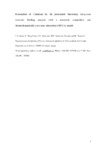Biosorption of Cadmium by the Protonated Macroalga Sargasssum Muticum: Binding Analysis With a Non-Ideal, Competitive and Thermodynamically Consistent Adsorption (NICCA) Model

View/
Use this link to cite
http://hdl.handle.net/2183/175Collections
- Investigación (FCIE) [1227]
Metadata
Show full item recordTitle
Biosorption of Cadmium by the Protonated Macroalga Sargasssum Muticum: Binding Analysis With a Non-Ideal, Competitive and Thermodynamically Consistent Adsorption (NICCA) ModelAuthor(s)
Date
2005Citation
Journal of colloid interface science, 2005, vol. 289, iss. 2, p. 352-358
Abstract
[Abstract] Protonated biomass of the seaweed Sargassum muticum was investigated for its ability to remove cadmium(II) from aqueous solutions. In this work, a non-ideal, semi-empirical, thermodynamically consistent (NICCA) isotherm was proposed to fit the experimental ion binding data obtained in NaNO3 0.05 mol·L-1. This model describes satisfactorily the competition between protons and metal ions. Moreover, it reflects the complexity of the macromolecular systems that take part in biosorption considering the heterogeneity of the sorbent. It was demonstrated in this work that NICCA isotherm constitutes a great improvement with respect to a simpler Langmuir competitive equation, which was not able to describe satisfactorily all the experimental data. Potentiometric acid-base titrations in absence of cadmium were made to estimate the maximum amount of acid functional groups (2.61 mmol·g-1), and the conditional proton binding parameters, logHK~ (3.8) and mH (0.54). The values of the binding parameters for the cadmium ion were chosen to provide the best simultaneous description of the isotherm at pH 4.5, as well as the dependence of cadmium adsorption on pH. Values of logCdK~ (3.1), nCd (1.8) and p (0.19) in the case of NICCA isotherm or log KCd (2.94-3.4) for Langmuir competitive models were obtained. Kinetic experiments were performed at two different pH values (3.0 and 4.5), establishing the time dependence that represents the sorption of cadmium with a pseudo-second-order kinetic model. It was observed that 4 hours are enough to ensure that the equilibrium uptake was reached.
Keywords
Biosorption
Algae
Cadmium
Sargassum muticum
Cross-link
NICCA
Algae
Cadmium
Sargassum muticum
Cross-link
NICCA
Editor version
ISSN
0021-9797





